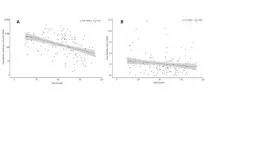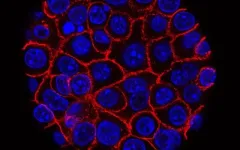(Press-News.org) CAMBRIDGE, MA -- Much of the carbon in space is believed to exist in the form of large molecules called polycyclic aromatic hydrocarbons (PAHs). Since the 1980s, circumstantial evidence has indicated that these molecules are abundant in space, but they have not been directly observed.
Now, a team of researchers led by MIT Assistant Professor Brett McGuire has identified two distinctive PAHs in a patch of space called the Taurus Molecular Cloud (TMC-1). PAHs were believed to form efficiently only at high temperatures -- on Earth, they occur as byproducts of burning fossil fuels, and they're also found in char marks on grilled food. But the interstellar cloud where the research team observed them has not yet started forming stars, and the temperature is about 10 degrees above absolute zero.
This discovery suggests that these molecules can form at much lower temperatures than expected, and it may lead scientists to rethink their assumptions about the role of PAH chemistry in the formation of stars and planets, the researchers say.
"What makes the detection so important is that not only have we confirmed a hypothesis that has been 30 years in the making, but now we can look at all of the other molecules in this one source and ask how they are reacting to form the PAHs we're seeing, how the PAHs we're seeing may react with other things to possibly form larger molecules, and what implications that may have for our understanding of the role of very large carbon molecules in forming planets and stars," says McGuire, who is a senior author of the new study.
Michael McCarthy, associate director of the Harvard-Smithsonian Center for Astrophysics, is another senior author of the study, which appears today in Science. The research team also includes scientists from several other institutions, including the University of Virginia, the National Radio Astronomy Observatory, and NASA's Goddard Space Flight Center.
Distinctive signals
Starting in the 1980s, astronomers have used telescopes to detect infrared signals that suggested the presence of aromatic molecules, which are molecules that typically include one or more carbon rings. About 10 to 25 percent of the carbon in space is believed to be found in PAHs, which contain at least two carbon rings, but the infrared signals weren't distinct enough to identify specific molecules.
"That means that we can't dig into the detailed chemical mechanisms for how these are formed, how they react with one another or other molecules, how they're destroyed, and the whole cycle of carbon throughout the process of forming stars and planets and eventually life," McGuire says.
Although radio astronomy has been a workhorse of molecular discovery in space since the 1960s, radio telescopes powerful enough to detect these large molecules have only been around for a little over a decade. These telescopes can pick up molecules' rotational spectra, which are distinctive patterns of light that molecules give off as they tumble through space. Researchers can then try to match patterns observed in space with patterns that they have seen from those same molecules in laboratories on Earth.
"Once you have that pattern match, you know there is no other molecule in existence that could be giving off that exact spectrum. And, the intensity of the lines and the relative strength of the different pieces of the pattern tells you something about how much of the molecule there is, and how warm or cold the molecule is," McGuire says.
McGuire and his colleagues have been studying TMC-1 for several years because previous observations have revealed it to be rich in complex carbon molecules. A few years ago, one member of the research team observed hints that the cloud contain benzonitrile -- a six-carbon ring attached to a nitrile (carbon-nitrogen) group.
The researchers then used the Green Bank Telescope, the world's largest steerable radio telescope, to confirm the presence of benzonitrile. In their data, they also found signatures of two other molecules -- the PAHs reported in this study. Those molecules, called 1-cyanonaphthalene and 2-cyanonaphthalene, consist of two benzene rings fused together, with a nitrile group attached to one ring.
"Detecting these molecules is a major leap forward in astrochemistry. We are beginning to connect the dots between small molecules -- like benzonitrile -- that have been known to exist in space, to the monolithic PAHs that are so important in astrophysics," says Kelvin Lee, an MIT postdoc who is one of the authors of the study.
Finding these molecules in the cold, starless TMC-1 suggests that PAHs are not just the byproducts of dying stars, but may be assembled from smaller molecules.
"In the place where we found them, there is no star, so either they're being built up in place or they are the leftovers of a dead star," McGuire says. "We think that it's probably a combination of the two -- the evidence suggests that it is neither one pathway nor the other exclusively. That's new and interesting because there really hadn't been any observational evidence for this bottom-up pathway before."
Carbon chemistry
Carbon plays a critical role in the formation of planets, so the suggestion that PAHs might be present even in starless, cold regions of space, may prompt scientists to rethink their theories of what chemicals are available during planet formation, McGuire says. As PAHs react with other molecules, they may start to form interstellar dust grains, which are the seeds of asteroids and planets.
"We need to entirely rethink our models of how the chemistry is evolving, starting from these starless cores, to include the fact that they are forming these large aromatic molecules," he says.
McGuire and his colleagues now plan to further investigate how these PAHs formed, and what kinds of reactions they may undergo in space. They also plan to continue scanning TMC-1 with the powerful Green Bank Telescope. Once they have those observations from the interstellar cloud, the researchers can try to match up the signatures they find with data that they generate on Earth by putting two molecules into a reactor and blasting them with kilovolts of electricity, breaking them into bits and letting them recombine. This could result in hundreds of different molecules, many of which have never been seen on Earth.
"We need to continue to see what molecules are present in this interstellar source, because the more we know about the inventory, the more we can start trying to connect the pieces of this reaction web," McGuire says.
INFORMATION:
The research was funded by NASA, the Smithsonian Institute, the National Science Foundation, the Alexander von Humboldt Foundation, and the European Union's Horizon 2020 research and innovation program.
One of great mysteries of human biology is how a single cell can give rise to the 37 trillion cells contained in the average body, each with its own specialized role. Researchers at Yale University and the Mayo Clinic have devised a way to recreate the earliest stages of cellular development that gives rise to such an amazing diversity of cell types.
Using skin cells harvested from two living humans, researchers in the lab of Yale's Flora Vaccarino were able to track their cellular lineage by identifying tiny variations or mutations contained within the genomes of those cells.
These "somatic" or non-inherited mutations are generated at each cell division during a human's development. The percentage of cells bearing the traces of any ...
The small intestine is ground zero for survival of animals. It is responsible for absorbing the nutrients crucial to life and it wards off toxic chemicals and life-threatening bacteria.
In a new study published March 18 in the journal Science, Yale researchers report the critical role played by the gut's immune system in these key processes. The immune system, they found, not only defends against pathogens but regulates which nutrients are taken in.
The findings may provide insights into origins of metabolic disease and malnutrition that is common in ...
93 million years ago, bizarre, winged sharks swam in the waters of the Gulf of Mexico. This newly described fossil species, called Aquilolamna milarcae, has allowed its discoverers to erect a new family. Like manta rays, these 'eagle sharks' are characterised by extremely long and thin pectoral fins reminiscent of wings. The specimen studied was 1.65 metres long and had a span of 1.90 metres.
Aquilolamna milarcae had a caudal fin with a well-developed superior lobe, typical of most pelagic sharks, such as whale sharks and tiger sharks. Thus, its anatomical features thus ...
It's not just how hot the fires burn - it's also where they burn that matters. During the recent extreme fire season in Australia, which began in 2019 and burned into 2020, millions of tons of smoke particles were released into the atmosphere. Most of those particles followed a typical pattern, settling to the ground after a day or week; yet the ones created in fires burning in one corner of the country managed to blanket the entire Southern hemisphere for months. A pair of Israeli scientists managed to track puzzling January and February 2020 spikes in a measure of particle-laden haze to those fires, and then, in a paper recently published in Science, they ...
INDIANAPOLIS -- The ongoing COVID-19 pandemic is keeping millions of Americans from their usual offices, as they find themselves still working at home. Even with the vaccine now being distributed, working from home may still be the future for some, and new research suggests the resulting work loneliness negatively impacts employee well-being. ...
Researchers who simulated early stages of the SARS-CoV-2 outbreak in Wuhan, China, conclude that the virus was likely circulating earlier than has been described, possibly even in mid-October 2019. The findings do not reveal whether the virus that first emerged was less "fit" than the virus that spread throughout China, say the authors, but the estimates do further distance the first ("index") case from the outbreak at the Huanan Seafood Wholesale Market, which has received much attention. A concerted effort has been made to determine when the SARS-CoV-2 virus ...
Have you forgotten where you laid your keys? Ever wondered where you had parked your car? Or having trouble remembering the name of the new neighbor? Unfortunately, these things seem to get worse as one gets older. A big question for researchers is where does benign forgetfulness end and true disease begin?
One of the keys to having a healthy brain at any age is having a healthy blood-brain barrier, a complex interface of blood vessels that run through the brain. Researchers reviewed more than 150 articles to look at what happens to the blood-brain barrier as we age. Their findings were published March 15 in Nature ...
LOS ALAMOS, N.M., March 18, 2021--A new, simpler solution process for fabricating stable perovskite solar cells overcomes the key bottleneck to large-scale production and commercialization of this promising renewable-energy technology, which has remained tantalizingly out of reach for more than a decade.
"Our work paves the way for low-cost, high-throughput commercial-scale production of large-scale solar modules in the near future," said Wanyi Nie, a research scientist fellow in the Center of Integrated Nanotechnologies at Los Alamos National Laboratory and corresponding ...
During a pandemic like COVID-19, vulnerable countries are traditionally the focus of global attention and concern. However, new research suggests that we need to rebuild our understanding. A study published in KeAi's Global Health Journal, examined the relationship between state vulnerabilities (measured using the Fragile States Index (FSI) from Fund for Peace) and COVID-19 incidence and death rates in 146 countries. The FSI consists of 12 specific indicators covering cohesion, economy, politics and society. "When using the total FSI score for statistical analysis, we were surprised to find that, overall, the more fragile countries had lower cumulative incidence and fatality rates for COVID-19," explains one of the study's authors, Yangmu ...
In new findings published online March 18, 2021 in the journal Cancer Cell, an international team of researchers, led by scientists at University of California San Diego School of Medicine and Moores Cancer Center, describe how pancreatic cancer cells use an alternative method to find necessary nutrients, defying current therapies, to help them grow and spread.
Pancreatic cancer accounts for roughly 3 percent of all cancers in the United States, but it is among the most aggressive and deadly, resulting in 7 percent of all cancer deaths annually. Pancreatic cancer is especially deadly once it metastasizes, with the number of people who are alive five years later declining from 37 percent to just 3 percent.
All cancer cells require a constant supply of nutrients. Some types ...



